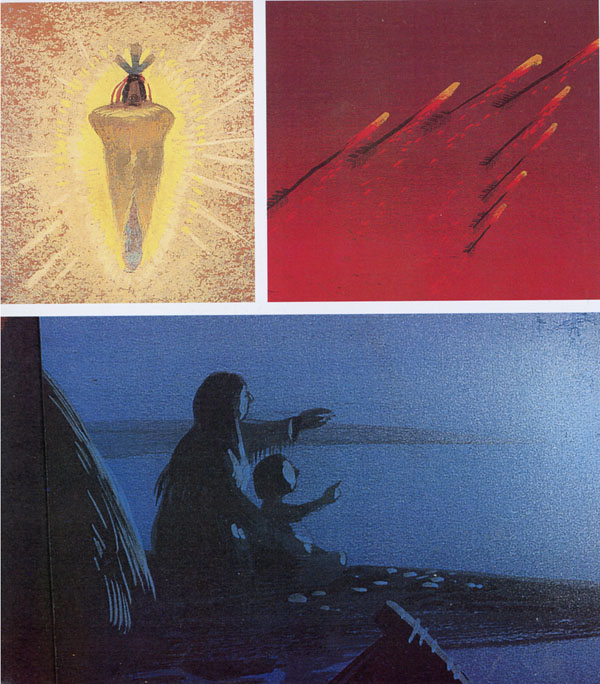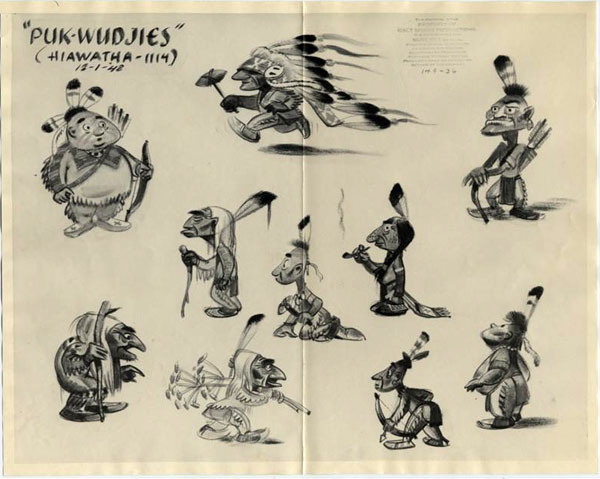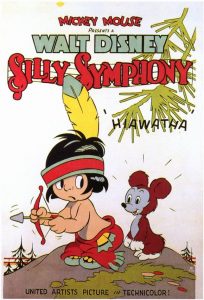The Song of Hiawatha is a famous 1855 epic poem written by Henry Wadsworth Longfellow about the fictional adventures of an Indian warrior named Hiawatha based on Native American legends. Walt Disney first encounted the poem when he was a student at Benton Elementary School in Marceline, Missouri.
Disney did produce the Silly Symphony Little Hiawatha in May 1937 which was about the misadventures of a typical “cute” little kid whose pants kept falling down. He had to be saved from an angry bear by the animals he had been too softhearted to kill.
The story has no real connection to the epic poem and the title was simply chosen for its name recognition by an audience just as it was by other cartoon studios. The character later appeared in several stories in Walt Disney’s Comics & Stories published by Dell Comics as well as four single issues of Dell’s Four Color comic series.
In 1940, storyman Ted Sears worked up a serious cartoon short entitled Pipe of Peace where Hiawatha playing his flute brought peace between all the animals and humans.
As animators Frank Thomas and Ollie Johnson wrote in their book Disney Animation: The Illusion of Life, “Walt was always way ahead of any of us, searching for new procedures, new forms of entertainment. One theme that kept haunting him was the story of Hiawatha. He kept bringing it up over the years, trying to find the right way to do something with it.
 “He said to us, ‘There’s something there, y’know? Something we could do – something that’s right for us. I don’t know what it is or how we’d do it. Don’t think of a film, don’t even think of a show – don’t limit your thinking to a regular theater. Maybe it’s something out in the woods, or on a mountain, maybe the people are brought in – or – I don’t know – but there’s something there!’ He felt the subject needed something beyond a film to be properly presented.”
“He said to us, ‘There’s something there, y’know? Something we could do – something that’s right for us. I don’t know what it is or how we’d do it. Don’t think of a film, don’t even think of a show – don’t limit your thinking to a regular theater. Maybe it’s something out in the woods, or on a mountain, maybe the people are brought in – or – I don’t know – but there’s something there!’ He felt the subject needed something beyond a film to be properly presented.”
Author Bob Thomas wrote in Walt Disney: An American Original, “A Hiawatha feature metamorphosed over a period of twenty years and when a story man lacked an assignment, Walt instructed, ‘Put him on Hiawatha’. But, despite all the efforts, Hiawatha was never produced.”
In 1943, Walt seriously started work on Hiawatha as a feature film. At one point, he considered having Native American artists do concept art and to employ it in some way in the finished film.
Starting in animation, Dick Kelsey became an art director at the studio on Pinocchio (1940), Fantasia (“Rite of Spring segment) (1940), Dumbo (1941) and Bambi (1942). After serving in the Marines during World War II, Walt put him in charge of a crew of artists to create storyboards for the proposed Hiawatha animated feature. In 1948 and 1949, Kelsey almost single-handedly produced an impressive number of atmospheric storyboards.

They were so evocative and accurate that decades later they were pulled out of storage to be studied for the Disney animated feature Pocahontas (1995). The research on historic costuming and background material had been impressive.
From an Associated Press newspaper account dated September 12, 1948:
“Dick Kelsey, one of Disney chief staff artists will spend six weeks (starting Sept 25) touring the Great Lakes Region sketching and documenting the settings of Longfellow s famous narrative poem.
“His Itinerary includes Chicago, Minneapolis-St. Paul, the shores of Lake Superior and Michigan, Ann Arbor, Lansing and Detroit across Lake Erie to Buffalo then through Rochester the Finger Lakes district the Mohawk Valley down the Hudson to New York and on to Washington for museum data. Color camera records will supplement his sketches.
“The finished cartoon likewise will be in color. Kelsey’s will be no easy task in this modern era since he insists he will try to recapture both the spirit and the look of Hiawatha’s land. Every remaining forest, prairie, lake and river associated with the Indian legend will be visited by boat, automobile, train, horse or on foot, he declared.
“He has arranged to study museum material in Chicago, St Paul, Minneapolis, and Rochester the American Museum of Natural History and the Heye Foundation in New York and the Smithsonian Institute and the Bureau of Indian Affairs in Washington. At Naples, NY he will confer with Dr. Arthur C. Parker, director emeritus of the Rochester Museum, an authority on American Indian life and lore.”
The story kept evolving as Walt sought to condense the sprawling poem into a story that could be told within the confines of a single film. At one point, Walt even considered having the characters deliver their lines in sign language and so research was done at the Smithsonian Institution but was abandoned as the story became too complicated to tell in that fashion.

An early version of the story started with an inter-tribal war and the Great Spirit sending a deliverer in the form of Hiawatha to re-establish the peace and prosperity. Disney storymen added a villain named Tadodaho who was a feared warrior and whose jealousy of Hiawatha results in various acts of treachery including killing Hiawatha’s best friend. Eventually the villain dies in a massive snow storm and Hiawatha is vindicated from all the earlier actions Tadodaho took to undermine Hiawatha in front of the tribe.
Kelsey told the other artists at the studio that “Walt doesn’t want to make this a light thing…he wants it (to have) a terrific musical accompaniment – almost Christ-like but not quite… Walt said it was originally his idea to get the storyboards up to show the material we are going to work with, then call in the composer – tell the story like we just told it – let the composer write a suite called ‘The Hiawatha Suite’ – then go back and start working from the composer’s musical score.”
On December 8, 1948, the studio held a showing for all of the artwork and story that had been done on the feature. While most praised the artwork, others feared that the approach was too “highbrow” in its seriousness, much like the earlier unsuccessful Fantasia (1940) and not what the audience would expect of a Disney animated feature.
Certainly the film faced many challenges including finding enough skilled animators who could handle drawing realistic human figures. It was also considered risky because the Disney Studio still had not recovered financially from World War II so the decision was made to concentrate on Cinderella (1950) which was a wise choice since it was both a critical and financial hit.
In September 1949, the story of Hiawatha was once again reworked so that it was told in flashback format to a white missionary to the tribe. In that way, it didn’t have to be a straight story but focused on the best segments. Kelsey did even more storyboards. The villain Tadodaho disappeared and was replaced by the evil magician Pearl-Feather and he battled with Hiawatha for the big climax.
Most people feel that Walt abandoned the project by the end of 1949 but press articles about the forthcoming feature appeared as late as 1951.



 Jim Korkis is an internationally respected animation historian who in recent years has devoted his attention to the many worlds of Disney. He was a columnist for a variety of animation magazines. With his former writing partner, John Cawley, he authored several animation related books including The Encyclopedia of Cartoon Superstars, How to Create Animation, Cartoon Confidential and Get Animated’s Animation Art Buyer’s Guide. He taught animation classes at the Disney Institute in Florida as well as instructing classes on acting and animation history for Disney Feature Animation: Florida.
Jim Korkis is an internationally respected animation historian who in recent years has devoted his attention to the many worlds of Disney. He was a columnist for a variety of animation magazines. With his former writing partner, John Cawley, he authored several animation related books including The Encyclopedia of Cartoon Superstars, How to Create Animation, Cartoon Confidential and Get Animated’s Animation Art Buyer’s Guide. He taught animation classes at the Disney Institute in Florida as well as instructing classes on acting and animation history for Disney Feature Animation: Florida.




















































Nice! I would like to see an article about “Scruffy”, another abandoned Disney project inspired by Paul Gallico’s book of the same name.
A fascinating story. I recall there was a live-action Hiawatha movie around this time that came under fire for being “Communist propaganda”, so Cold War politics might have helped to put the kibosh on Disney’s project. In any event, “Cinderella” was the hit the studio needed at that point in time.
My biggest regret about “Hiawatha” not being made is that we’ll never get to see the backgrounds Mary Blair might have painted of the Pictured Rocks area of Lake Superior. Photographs seldom do the landscape justice because the weather is usually bad, and even on the rare clear day the rocks get little sunlight because the cliffs face north; but Blair’s treatment would have been nothing less than spectacular.
I wonder if it would’ve had the same future as Song of the South did.
The Silly Symphony Sunday comic strip also featured a series of Little Hiawatha gag pages from November 10, 1940 to July 12, 1942. The info in this article helps to make the long run of Hiawatha make more sense.
This is a very intriguing project. At this time, Walt still wanted to push animation beyond the established public perceptions. A Hiawatha film that was dramatic and serious rather than the usual lighthearted fairy tale would have been revolutionary, and the extensive research suggests that it could have been truer to Native American cultures than the usual “savage Indians” seen in Hollywood at the time. Whether it would have been a box-office success, or whether it would be seen as an embarrassment in later years.as Song of the South was, is harder to predict. At any rate, it would have been a landmark in animation and would have likely had an effect on the films that are made now.
Little Hiawatha, along with Toby Tortoise and Max Hare, appears fleetingly as a face on a star in the long version of the Mickey Mouse Club animated opening. Guessing that was just a nod to their familiarity in comics (Uncle Scooge also appears briefly).
I’ve always wondered why “Wind in the Willows” ended up at “featurette” length. There’s certainly enough incident in the book, and I think there are at least three animated features from other studios as well as stage plays and the live action one starring Terry Jones. Plus at least two TV series that follow Toad into further manias and misadventures.
I can imagine Walt and/or his story men trying to pound the book into a conventional Hollywood story, perhaps shoehorning cute children or even a heroine into what’s essentially a tale of stodgy bachelors trying to reign in a reckless friend. Or, more likely, fixating on the stolen car story and cluttering it up.
When “Alice in Wonderland” finally appeared later, it’s perhaps worth noting they’d discarded all attempts to impose a Hollywood plot (including, reportedly, a romantic one) and let Alice explore, as she does in the book.
Thanks for further info about Dick Kelsey, who also created breathtaking cover art for Disneyland Records, including Camarata’s “Seasons” LP series.
Small thing… Benton Grammar School was in Kansas City. Walt still could have been exposed to the stories there.
“Have you heard the tragedy of Disney’s Hiawatha?”
“Yes, as a matter of fact I have.”
In 1996 I inherited a framed “cell” of the 1937 cartoon “Hiawatha.” I have taken it to art galleries and contacted Disney. Of course, it bears little resemblance to today’s “cells” of modern Disney cartoons.
The authenticity is documented and it is in excellent condition. Considering the history of “Hiawatha” and Walt Disney’s apparent personal passion compared to the current disinterest, do I have trash or a treasure?
I sounds to me like you have a TREASURE!
I have a vinyl LP of the music from “Song of the South” and a hardback children’s book. I would have to unearth them from boxes to determine their condition. “Song of the South” fell by the wayside, but is there any historical value to this gentle tale now?
This is not a duplicate. My original comment referenced “Hiawatha.” After further reading I found mention of “Song of the Soth.” Hence, this comment.
Hanna – We can’t help you on this website to determine what value your heirlooms and collectibles are. Please do some research on eBay. But it does sound like you have some rare items.
Good luck!